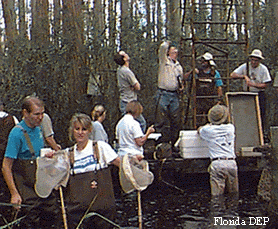Volunteer Monitoring to Protect Wetlands
Volunteer Monitoring Fosters a Sense of Stewardship
Volunteer monitoring programs empower citizens to become more active stewards of wetlands in their communities. Volunteer programs provide an opportunity for land owners, children and other community members to become more familiar with the functions and values of wetlands in their watershed as well as the pressures placed on these resources. Informed citizens can play a key role in encouraging land and water stewardship in all sectors of society, from industry to private homeowners, and from housing developers to municipal sewage treatment managers.
Volunteer Monitoring Provides Valuable Data
 In 1995, elementary school students in Minnesota discovered frogs with malformations. They captured the nation's attention and professionals and other volunteers have subsequently found malformed amphibians across the Great Lakes region and in northern New England.
In 1995, elementary school students in Minnesota discovered frogs with malformations. They captured the nation's attention and professionals and other volunteers have subsequently found malformed amphibians across the Great Lakes region and in northern New England.
Volunteer monitoring programs can provide data for federal, state, tribal and local water quality agencies and private organizations. Although these data are generally not as rigorous as data collected by trained professionals, organizations can use these data to screen areas that otherwise may not be assessed. If the volunteers spot warning signs, they can alert professionals to the problem, and the professionals can follow up with more detailed assessments. As scientists make more progress in developing wetland biological assessment methods, volunteer monitoring of wetlands will increase. In the meantime, there are other ways that volunteers can monitor wetlands.

More Wetland Volunteer Monitoring resources are available below and in the Volunteer Monitoring section of the Wetland Bioassessment Links page.
Information about state volunteer projects is available at Wetland Volunteer Monitoring Programs.
Volunteer Wetland Monitoring: An Introduction and Resource Guide (PDF)(51 pp, 102 MB, About PDF) - This booklet provides an introduction to why and how people monitor wetlands and includes a multi-page resource guide to handbooks and manuals that offer detailed information on wetland monitoring for the layperson. While it is not a methods manual, the guide also offers advice on approaching wetland monitoring, most of which is a synthesis of comments received from organizers of a wetland monitoring programs across the United States.
"Starting Out in Volunteer Water Monitoring" - brochure
Handbook for Wetlands Conservation and Sustainability Exit - This handbook has an overview of wetlands ecology, functions, and values and provides a framework for hands-on activities to monitor wetlands health that you can follow directly or adapt to fit your local needs.
Wetlands Walk Manual (PDF)(10 pp, 273 K, About PDF) and Supplement Worksheets (PDF)(8 pp, 132 K, About PDF) - offers citizens the opportunity to become partners in learning about wetlands.
